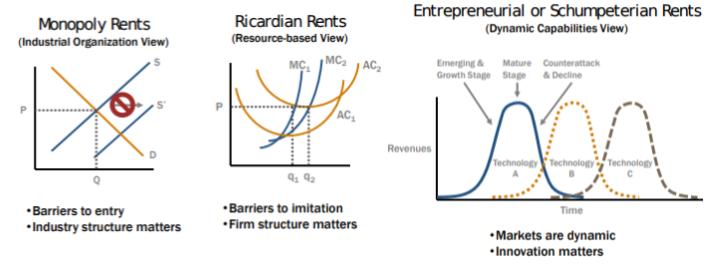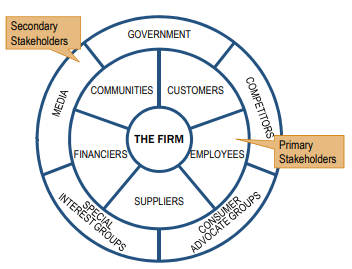Advanced Business Strategy Coursera. Certification link.
- Dynamic Strategy
- International Strategy
- Diversification Strategy
- Stakeholder Strategy
- Final Assignment
1. Dynamic Strategy
The circumstances changed (new technology, new business model, change in demand, etc.) and they were not able to transition: Studebaker Brothers, Remington typewriter, KODAK, SEARS.
- The Fundamental Principle of Business Strategy : “If everyone can do it, it’s difficult to create and capture value from it.” or “In a perfectly competitive market, no firm realizes economic profits (rents).”
- First Corollary to the Fundamental Principle “Imitation is the sincerest form of flattery.” or “If some competitive positions are more favorable than others, we would expect firms to adopt those strategies.”
- Second Corollary to the Fundamental Principle “Change is the only constant.” or, alternatively “Over time, economic profits (rents) tend to dissipate as markets evolve.”
- Monopoly Rents (Industrial Organization View) : Barriers to entry; Industry structure matters.
- Ricardian Rents (Resource Based View) : Barriers to imitation; Firm structure matters.
- Entrepreneurial or Schumpeterian Rents (Dynamic Capabilities View).
- Premise that markets are dynamic.
- Economic rents due to temporal advantages (i.e. Schumpeterian rents).
- Timing and adaptation is critical.

Competitive Life Circle (CLC) Common Patterns of Industries.

- Ferment : innovation on product features, exploratory, Profits are made through differentiation and niche placement.
- Dominant Design : Innovation shifts to process, delivery, and service. large, efficient firms remain.
- Disruption (new technology or business model emerges) :
- Exogenous technological change (technology push).
- Changes in market due to consumer shifts (demand pull).
- Competitive reordering : (some) New technologies (may worse at first) supplant old as they improve.
- A shakeout occurs as firms exit the industry (in growth phase). The shakeout transition tends to happen with great regularity across different industries, although the intensity varies in different industries.
Why do incumbent firms often fail?
- No better positioned than new entrants : Innovations render existing capabilities valueless: technologically, organizationally, and market-wise. (Studebaker Brothers)
- Worse positioned than entrants : Incumbent firms fail to see value in new innovations and have difficulty adopting: core rigidities. (KODAK)
- Select not to change : a fundamental trade-off between short-term and long-term competencies (e.g., cannibalization).
When do incumbent firms succeed?
- Innovation often requires extensive capital and expertise. Not easily available to small/newly-founded firms.
- Customers desire the assurance of established firms. Often risk averse, unlikely to try new things.
- Incumbent firms may leverage complementary resources or capabilities to their advantage.
- Incumbent has a “dynamic capability” to adjust to changing business conditions.
Competitive Life Cycle Analysis (learn from the past).
| Phase | Timing | Severity |
|---|---|---|
| Disruption | How long is the mature phase? | Radical or incremental? |
| Annealing | How long is the emergent phase? | Dominant design or multiple designs? |
| Shakeout | How long is the growth phase? | Winner-take-all, duopoly, contested? |
| Overall | Slowly evolving or hyper-dynamic? | First mover advantage? |
2. International Strategy
Analysis pipeline : (1) Industry Differences; (2) Firm Differences (within an industry); (3) Strategic Questions.
Factors to consider:
- Global integration : to be more efficiently or effectively.
- Local responsiveness : adaptation to local conditions.
Patterns of Internationalization : (1) International Trade (exportation of goods/services to foreign customer base in anther country); (2) Foreign Direct Investment (establish operations through acquisition or start-up in foreign location).
| Low (Foreign Direct Investment) | High (Foreign Direct Investment) | |
|---|---|---|
| High (International Trade) | International Industries Aerospace, Military hardware, Agriculture. | Global Industries Automobiles, Semiconductors, Oil. |
| Low (International Trade) | Sheltered Industries (local) Railroads, Hairdressing, Milk. | Multi-Domestic Industries (high national differentiation) Packaged goods, Hotels, Consulting. |
Where should a firm compete ? Valuable Competitive Position. What market should you enter? Which capabilities ? How to complete ?
How to enter the market ? (1) Exporting, “Trading” industry, internationalized customer base; (2) Licensing/Alliances, partnering approach, higher or local responsiveness; (3) Foreign Direct Investment, Direct operations in the new location. Acquisition (established host-country firm) ? Greenfield (create new)?
3. Diversification Strategy
Scope refers to the businesses that a firm operates and how they govern those operations. Diversification Type : Single Business; Dominant Business; Related Business; Unrelated Business.
Financial Reasons to Diversify :
- Capitalize on opportunities in unrelated markets.
- Capitalize on opportunities in related markets.
- Reduce volatility (of earnings) by diversifying assets.
- Reduce risk (of bankruptcy) by diversifying assets/
Operational Reasons to Diversify (Caution (Synergies is hard), Alternatives (Outsourcing, Alliances)):
- Exploit economies of scale and scope. (lower costs. e.g. by eliminating duplicate effort)
- Transfer/leverage rent-generating assets. (share technology, know-how, reputations across different business)
- Improve coordination among businesses. (Create broad incentives for cooperation and information exchange)
Strategic Reasons to Diversify :
- Eliminate competition by subsidizing a price war. (dominant position in one business can help competing in another)
- Raise rivals’ costs (e.g. vertical foreclosure). (Exert power through backward and forward integration)
- Reduce rivalry through mutual forbearance. (Multipoint competition (competitors are in similar markets) reduces incentives to fight)
- Minimize transaction costs of using markets. (Often costly (impossible) to write complete contract, leading to “holdup” by partners)
Theory of the Firm (Why is all economic activity not organized through markets?)
- All economic activity is a series of “transactions” between independent economic actors.
- “Ownership” imparts residual rights of control.
- Ability to choose course when disagreements or unforeseen contingences arise.
- Creates common incentives and mechanisms for coordination.
- Minimizes risks and frictions of transacting through the market.
Limits on Firm Scope: (1) Government! (Antitrust to reduce monopoly power); (2) Bureaucratic Costs; (3) Agency Costs.
Evaluate the strategy and valuable competitive position of each business, and then analyze the synergies and value creation across different business units and the advantage of holding them all together under one firm.
| Business Unit Competitive Advantage : Low | Business Unit Competitive Advantage : High | |
|---|---|---|
| Industry Attractiveness: High | Hold | Build |
| Industry Attractiveness: Low | Harvest | Hold |
4. Stakeholder Strategy

A competitive stakeholder strategy creates value for all stakeholders and aligns with the organization's values and capabilities.Shape these relationship, so that value can be created ideally for all of them. (Example : “Whole Foods Market”)
- Align Interests.
- Stakeholder Issues Matrix & Stakeholder Impact Matrix (Alternative).
- Secondary Stakeholders: Institutional Pressures.
- Political actors may have self-interested motives to act against firms.
- Stakeholders may act (or call for action) against firms in response to: Normative conflict (conflicts with norms and beliefs) or Distributional conflict (often market failure).
| Issue | Employees | Customers | Government | Community | Shareholders |
| Product Safty | 3 | 1 | 1 | 1 | 3 |
| Job Fulfillment | 1 | 5 | 5 | 3 | 5 |
| Financial Returns | 3 | 5 | 5 | 5 | 1 |
| Impact on Environment | 3 | 3 | 1 | 1 | 5 |
Strategy and Ethics:
- Institutional/non-market strategies can seem overly instrumental.
- Also important to think beyond the immediate financial impact of effective stakeholder management.
- Seeing stakeholders as ends, and not just means to profits.
- Value creation involves values. what we value as an organization.